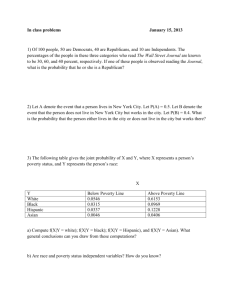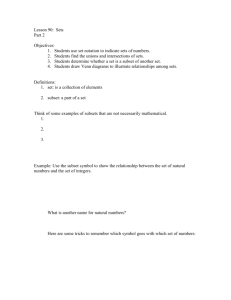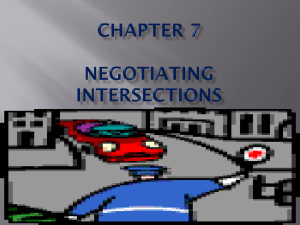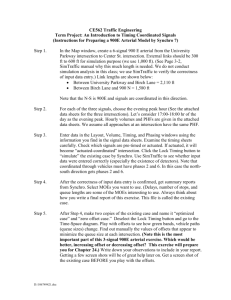Laboratory # 7: Pretimed Signal Coordination
advertisement
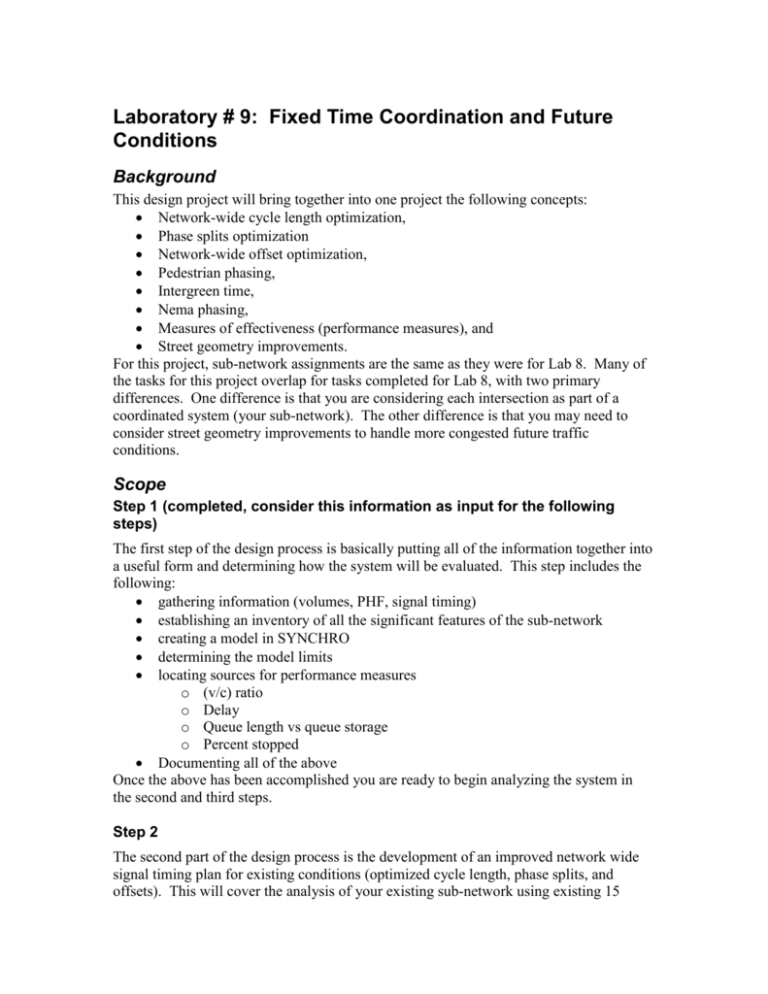
Laboratory # 9: Fixed Time Coordination and Future Conditions Background This design project will bring together into one project the following concepts: Network-wide cycle length optimization, Phase splits optimization Network-wide offset optimization, Pedestrian phasing, Intergreen time, Nema phasing, Measures of effectiveness (performance measures), and Street geometry improvements. For this project, sub-network assignments are the same as they were for Lab 8. Many of the tasks for this project overlap for tasks completed for Lab 8, with two primary differences. One difference is that you are considering each intersection as part of a coordinated system (your sub-network). The other difference is that you may need to consider street geometry improvements to handle more congested future traffic conditions. Scope Step 1 (completed, consider this information as input for the following steps) The first step of the design process is basically putting all of the information together into a useful form and determining how the system will be evaluated. This step includes the following: gathering information (volumes, PHF, signal timing) establishing an inventory of all the significant features of the sub-network creating a model in SYNCHRO determining the model limits locating sources for performance measures o (v/c) ratio o Delay o Queue length vs queue storage o Percent stopped Documenting all of the above Once the above has been accomplished you are ready to begin analyzing the system in the second and third steps. Step 2 The second part of the design process is the development of an improved network wide signal timing plan for existing conditions (optimized cycle length, phase splits, and offsets). This will cover the analysis of your existing sub-network using existing 15 minute flow rates. The analysis should include a comparison to Lab 8 conditions where no coordination was available and be performed at two levels as follows: individual intersections—consider the items listed below o intersection delay o queuing vs queue storage o lane group (v/c) ratios o excessive lane group delay o percent stopped o pedestrian service o safe intergreen times sub-network—consider the items listed below o system delay o percent stopped in the system o intersection problems affecting system operations Document all the above Step 3 After completing the second part of the design process, you should have a signal timing plan that works for existing traffic conditions. The purpose of this step is to determine the adequacy of the system in ten-years, given a 1.5% annual growth rate. The basic outcome of this step is a list of deficiencies in the system, given its predicted operations in ten years. Step 4 The fourth part of this project involves the design of an improved signal timing plan for your assigned sub-network given the future conditions and will include the following: Determine and document the following: o Phase plan for each intersection o Optimal sub-network cycle length (make sure that it works for all subnetwork intersections) o Phase splits for each intersection o Intergreen times for each intersection o Ped phase for each intersection o Offsets in a time-space diagram for each arterial Emphasize the following o Changes needed in intersection phasing in order to improve system operations o Modifications needed to existing intersection geometry Document all the above Deliverable The final design project is due in three weeks at the beginning of lab. The report (80% of Lab 9 grade) o will be double spaced. o will be in electronic format. o will be no longer than 15 pages (not counting figures and tables) in length. o body of discussion must be in 12 point font with at least one inch margins. o will use figures and tables to support your discussion. o will have all referenced data, figures, tables, and calculations included in the body of the document. The appendix is for supporting information that is not directly referenced in the text. In other words, if I need to see the information to follow the discussion then put it in the body of the report. o will sound like you understand the situation and are not afraid to explore why things are the way they are. Anybody can write a document summarizing numbers and actions taken. I expect you to interpret the numbers, explain why they are what they are, and defend why you did what you did. o will be well written containing few writing errors o will be consistent in its formatting and organization. The presentation (20% of Lab 9 grade) o 15-minute presentation. o given during lab on December 5th and 10th. o any media or software may be used.
